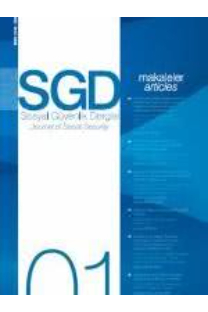Türkiye'de işsizlerin iş arama süresini belirleyen faktörler: 2007-2013 dönemi
Determinants of unemployeds job-seeking duration in Turkey: 2007-2013 time periods
___
- Abar, Hayri ve Abdülkerim Karaaslan (2013) Konut Talep Edenlerin Özellikleriyle Talep Edilen Konutun Özellikleri Arasındaki İlişkinin Çoklu Uyum Analizi Yöntemi İle İncelenmesi: Atatürk Üniversitesi Personeli Örneği, Atatürk Üniversitesi İktisadi ve İdari Bilimler Dergisi, 27(3), 232-339.
- Akın, H. Besim ve Elif Şentürk (2012) Bireylerin Mutluluk Düzeylerinin Ordinal Lojistik Regresyon ile İncelenmesi, Öneri, 10(37), 183-193.
- Alpar, Reha (2013) Çok Değişkenli İstatistiksel Yöntemler, (Ankara: Detay Yayıncılık).
- Anderson, Sally L. (2010) Duration of Unemployment in States, 2007-09, Monthly Labor Review, [http://www. bls.gov/opub/mlr/2010/12/art3full.pdf] (18.10.2014).
- Barak, N. Anıl (2005) Sıralı (Ordinal) ve Multinomial Logit Modeller Üzerine Bir Uygulama, Hacettepe Üniversitesi Sağlık Bilimler Enstitüsü, (Ankara: Basılmamış Yüksek Lisans Tezi).
- Bayram, Nuran (2004) Multinominal Lojistik Regresyon Analizinin İstihdamdaki İşgücüne Uygulanması, İstanbul Üniversitesi İktisat Fakültesi Mecmuası, 54 (2), 61-75.
- Begum, Nasima (2004) Characteristics of the Short-Term and Long-Term Unemployed, Labour Market Trends, Analysis in Brief, [www.statistics. gov.uk/articles/labour_market_trends/ unemp_in_brief.pdf] (17.10.2014).
- Bulut, Volkan (2011) Türkiyede İşsizlik Süresini Etkileyen Faktörlerin Yaşam Çözümlemesi ile İncelenmesi, Hacettepe Üniversitesi, Fen Bilimler Enstitüsü, (Ankara: Basılmamış Yüksek Lisans Tezi).
- Çiftçi, Cemil ve Atalay Çağlar (2014) Ailelerin Sosyo-Ekonomik Özelliklerinin Öğrenci Başarısı Üzerindeki Etkisi: Fakirlik Kader midir?, International Journal of Human Sciences, 11(2), 155-175.
- Çokluk, Ömay; Şekercioğlu, Güçlü ve Şener Büyüköztürk (2012) Sosyal Bilimler İçin Çok Değişkenli İstatistik: SPSS ve LISREL Uygulamaları, (Ankara: Pegem Akademi).
- Dănăcică, Daniela-Emanuela and Raluca Mazilescu (2014) Long-Term Unemployment Spells and Exit States of Men in Romania and Hungary, 1st International Conference Economic Scientific Research-Theoretical, Empirical and Practical Approaches, Procedia Economics and Finance, 8, 236- 245.
- European Commission (2012) Long- Term Unmeployment 2012, European Employment Observatory Review, Luxemburg.
- Gürsel, Seyfettin; Levent, Haluk, İlkkaracan, İpek, Ulus, Mustafa ve Enver Taştı (2004) Türkiyede İşgücü Piyasasının Kurumsal Yapısı ve İşsizlik, TÜSİAD: Yayın No. TÜSİAD-T/2004-11/381, İstanbul, [http://www.tusiad.org.tr/__rsc/shared/ file/issizlik04.pdf] (09.11.2014).
- Jimeno, Juan and Luis Toharia (1994) Unemployment and Labour Market Flexibility: Spain, (Fist Published), ILO, Geneva.
- Keskin, Sıddık (2001) Çoklu Uyum Analizi ve Bir Uygulaması, Tarım Bilimleri Dergisi, 7(4), 91-95.
- Kupets, Olga (2006) Determinants of Unemplyment Duration in Ukraine, Journal of Comparative Economics, 34, 228-247.
- Lechner, Ferdinand ve Petra Wetzel (July 2012) EEO Review: Long-Term Unemployment, 2012 Austria, European Employment Observatory, [http:// www.eu-employment-observatory. net/resources/reviews/Austria-LTU- July2012.pdf] (17.10.2014).
- Liva, Griņeviča, Kovaļevs Raimonds ve Rivža Baiba (2013) Long-Term Unemployment of Women as a Possibility to be Self-Employed, Regional Review/ Regionalais Zinojums, 9, 39-49.
- Llaudes, Ricardo (2007) The Phillips Curve and Long-Term Unemployment, European Central Bank:27, [http:// nzae.katipo.co.nz/wp-content/ uploads/2011/08/nr1215131164.pdf] (22.10.2014).
- Luca, Loretta de and Michele Bruni (1993) Unemployment and Labour Market Flexibility Italy, ILO, Geneva, [http://books.google.com.tr/books?hl=t r&id=cv5m5jyv6vAC&q=short+term# v=snippet&q=short%20term&f=false] (01.10.2014).
- Peng, Chao-Ying Joanne; Kuk, Lida Lee and Gary M. Ingersoll (2002), An Introduction to Logistic Regression Analysis and Reporting, The Journal of Educational Research, 96(1), 3-14.
- Suner, Abdullah ve Can Çelikoğlu (2010) Toplum Tabanlı Bir Çalışmada Çoklu Uygunluk Analizi ve Kümeleme Analizi ile Sağlık Kurumu Seçimi, Dokuz Eylül Üniversitesi İktisadi ve İdari Bilimler Dergisi, 25(2), 43-55.
- Sümbüloğlu, Kadir ve Beyza Akdağ (2007) Regresyon Yöntemleri ve Korelasyon Analizi, (Ankara: Hatipoğlu Yayınları).
- Şenel, Selma ve Betül Alatlı (Yaz 2014) Lojistik Regresyon Analizinin Kullanıldığı Makaleler Üzerine Bir İnceleme, Eğitimde ve Psikolojide Ölçme ve Değerlendirme Dergisi, 5(1), 35-52.
- Şentürk, Elif (2011) Mutluluk Düzeyinin Sosyo-Demografik Özelliklerle Lojistik Regresyon Analizi Aracılığıyla İncelenmesi ve Türkiye İçin Bir Uygulama, Marmara Üniversitesi Sosyal Bilimler Enstitüsü, (İstanbul: Basılmamış Yüksek Lisans Tezi).
- Tansel, Aysıt ve H. Mehmet Taşcı (2004) Determinants of Unemployment Duration for Men and Women in Turkey, IZA Discussion Paper Series, IZA DP no.1258, Germany, [http://ftp.iza.org/ dp1258.pdf] (02.11.2014).
- Tardanic, Richard (2014) Ordinal and Multinomial Logit Models, [http://www. fiu.edu/~tardanic/lec7.pps] (12.11.2014).
- Taşçı, Mehmet ve Ali Rıza Özdemir (2006) Trends in Long-Term Unemployment and Determinants of Incidence of Long-Term Unemployment in Turkey, Journal of Economic and Social Research, 7(2), 1-33, [http://jesr. journal.fatih.edu.tr/jesr.tasci.ozdemir. pdf] (15.10.2014).
- Tunalı, İhsan (2003) Background Study on Labour Market and Employment in Turkey, Final Report/June 27, Prepared for the European Training Foundation, [http://statik.iskur.gov.tr/tr/dis_iliskiler/ B S T- f i n a l % 2 0 r e p o r t % 2 0 _ 2 7 [ 1 ] . June.2003_.pdf] (02.11.2014).
- Australian Bureau of Statistics (1994) [http://www.abs.gov.au/AUSSTATS/ abs@.nsf/Lookup/4102.0Main+Features 20Sep+2011#3] (21.10.2014).
- EUROSTAT, [http://epp.eurostat. ec.europa.eu/statistics_explained/ index.php/Unemployment_and_ beyond], [http://ec.europa.eu/ eurostat/ramon/nomenclatures/index. cfm?TargetUrl=DSP_GLOSSARY_ NOM_DTL_VIEW&StrNom=CODED2 &StrLanguageCode=EN&IntKey=1691 0718&RdoSearch=BEGIN&TxtSearch= long&CboTheme=&IsTer=&IntCurrent Page=1&ter_valid=0] (20.10.2014).
- ILO, Key Indicators of the Labour Market 11, Long Term Unemployment, [http:// kilm.ilo.org/2011/download/kilm11EN. pdf] (20.10.2014).
- OECD Employment Database, [http://www.oecd.org/employment/ onlineoecdemploymentdatabase. htm#ltu] (20.10.2013).
- OECD Employment Outlook 2002, [ w w w. o e c d . o r g / e m p l o y m e n t / emp/17652683.pdf] (21.10.2014).
- OECD Employment Outlook 2014, [http://www.keepeek.com/Digital- Asset-Management/oecd/employment/ oecd-employment-outlook-2014_empl_ outlook-2014-en#page1] (05.11.2014).
- ReStore (National Centre for Research Methods) (2014) Using Statistical Methods in Education Research, [http:// www.restore.ac.uk/srme/www/fac/ soc/wie/research-new/srme/modules/ mod5/4] (10/11/2014).
- Statistics Finland, [http://www.stat. fi/meta/kas/pitkaaikaistyot_en.html] (21.10.2014).
- Statistics Netherlands, Labour and Social Security, [http://www.cbs.nl/en-GB/ menu/themas/arbeid-sociale-zekerheid/ publicaties/artikelen/archief/2012/2012- 3602-wm.htm] (01.11.2014).
- Swiss Statistics, [http://www.bfs.admin. ch/bfs/portal/en/index/themen/03/03/ blank/key/erwerbslose0/struktur.html] (21.10.2013).
- The World Bank, [http://databank. worldbank.org/data/views/reports/ metadataview.aspx] (21.10.2013).
- TÜİK (Türkiye İstatistik Kurumu) (2013) TÜİK Hanehalkı İşgücü Araştırması 2013 Mikro Veri Seti [http://www. tuik.gov.tr/MicroVeri/Hia_2013/turkce/ metaveri/amac/index.html] (13/11/2014)
- United States Department of Labor, U.S. Bureau of Labor Statitics, [http://www. bls.gov/bls/cps_fact_sheets/ltu_mock. htm] (17.10.2014).
- United States Department of Labor, [http://www.doleta.gov/grants/pdf/SGA_ DFA_PY_13_07.pdf] (19.10.2014).
- United States Department of Labor, U.S. Bureau of Labor Statitics, [http://www. bls.gov/bls/cps_fact_sheets/ltu_mock. htm] (20.10.2014).
- Williams, Richard (2014) Models for Ordinal Outcomes II: Generalized Ordered Logit Models, [http:// www3.nd.edu/~rwilliam/xsoc73994/ Gologit2Part1.pdf] (13/11/2014)
- ISSN: 2146-4839
- Yayın Aralığı: 2
- Başlangıç: 2011
- Yayıncı: SOSYAL GÜVENLİK KURUMU
6331 sayılı kanun'da iş güvenliği uzmanlığı: Nitelikleri, görevlendirilmeleri ve yetkilendirilmeleri
Türkiye'de işsizlerin iş arama süresini belirleyen faktörler: 2007-2013 dönemi
ATALAY ÇAĞLAR, Hanan KUMAŞ, Tuncay MORALI
İlker DAŞTAN, Volkan ÇETİNKAYA
6552 sayılı (torba) yasa sonrası asıl işveren - alt işveren ilişkileri
Türkiye'de sağlık reformlarının sağlık hakkı açısından değerlendirilmesi
